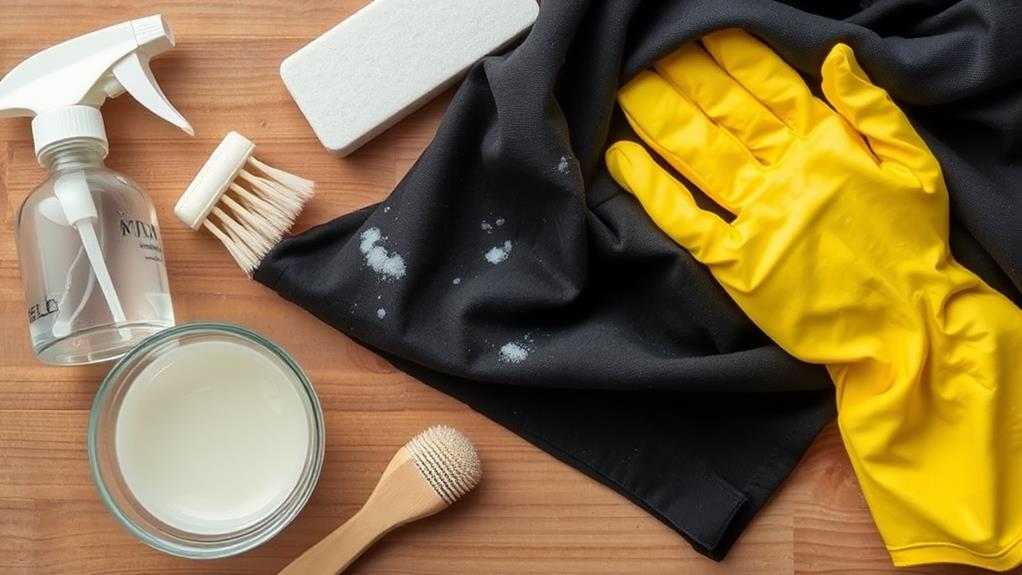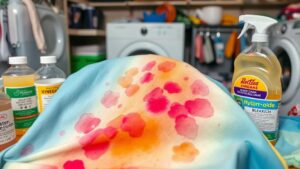Bleach stains on dark clothes might feel permanent, but you can tackle them with some simple DIY tricks. Start by immediately rinsing the area with cold water to limit damage. Blot the stain gently with a clean cloth to absorb excess bleach. For minor stains, try a paste of baking soda and water to help neutralize the discoloration. You can also use rubbing alcohol or fabric markers to blend colors and cover spots. If these methods don't fully restore your garment, there are more techniques to explore that might just bring your clothes back to life.
Understanding Bleach Stains
Bleach stains can be a frustrating issue for anyone with dark clothes. These stains happen when bleach interacts with the dye in dark fabrics, resulting in permanent discoloration that leaves lighter patches. The severity of the stains often depends on factors like bleach concentration, exposure time, and the type of fabric.
You'll find that natural fibers, such as cotton, are more susceptible to damage than synthetic ones like polyester. Understanding your financial health and tracking expenses can help you prevent unnecessary losses, similar to how regular reviews of savings and investments support informed decision-making in financial management.
Once bleach stains occur, they can't be removed like typical stains. Instead, you'll need to focus on color restoration or masking techniques. Acting quickly is key; rinsing with cold water immediately can help minimize damage and prevent further penetration into the fabric fibers.
The sooner you identify bleach stains, the better your chances of determining the best treatment approach. Different fabrics respond uniquely to neutralization and repair methods, so knowing what you're dealing with is essential.
Causes and Prevention
Accidental spills and splatters can easily lead to bleach stains on your dark clothes, making it vital to understand the causes behind these mishaps. One main cause of these stains is improper use of bleach products during laundry, especially when handling bleach with a high concentration.
Natural fibers like cotton and linen are particularly vulnerable to damage, so it's important to be cautious. To maintain your financial health while managing laundry expenses, consider budgeting tools like YNAB that can help you allocate funds effectively.
To prevent bleach stains, always check care labels for bleach safety before washing your clothes. Diluting bleach before application can greatly reduce the risk of staining. Using color-safe bleach alternatives is also a smart choice when doing laundry.
Separating whites from colors during washing is a key step to avoid getting bleach stains on your dark fabrics. Educate everyone in your household about proper bleach handling to minimize accidents.
Additionally, wearing protective clothing and rubber gloves while using bleach helps prevent unintentional contact with your dark clothes, further reducing the likelihood of stains on dark fabrics. By keeping these tips in mind, you can maintain your wardrobe and enjoy your clothes without the worry of bleach mishaps.
Pre-Treatment Steps
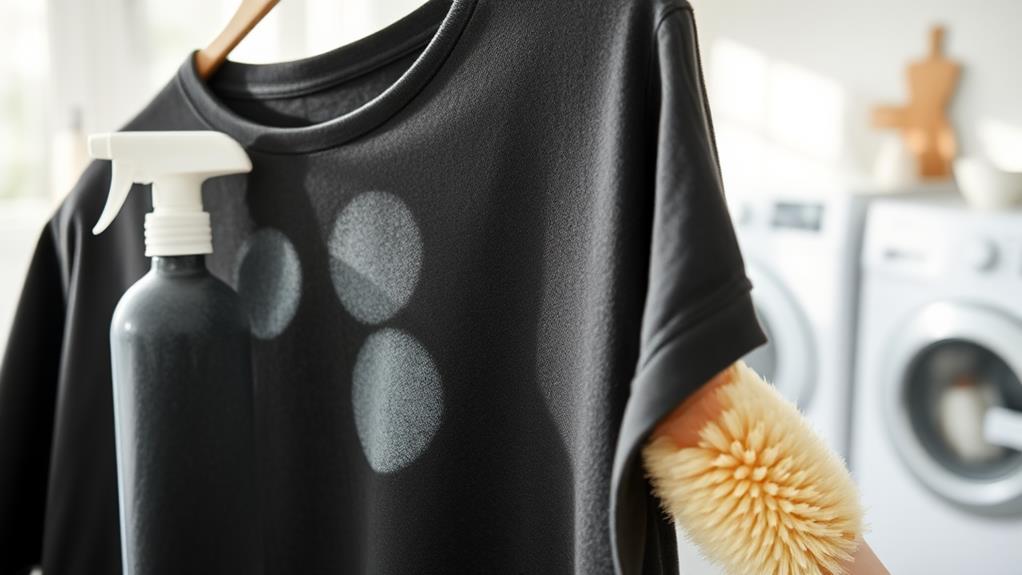
When tackling bleach stains on dark clothes, it's essential to act quickly and carefully. Start by identifying the fabric type, as different materials may require specific approaches for effective stain removal.
For instance, using the right techniques can help you manage the situation more effectively, much like how expense management apps streamline financial organization for users enhanced accuracy and organization. Before applying any treatment, conduct a colorfastness test on an inconspicuous area of the fabric to guarantee that it won't cause further discoloration.
Follow these pre-treatment steps:
- Gather necessary supplies, including a clean cloth, cold water, and any specific stain treatment products.
- Blot the stained area gently with a clean white cloth or paper towel to absorb excess bleach without spreading the stain.
- Rinse the affected area thoroughly with cold water from the back of the fabric, helping to push out the bleach and minimize damage.
Engaging in this pre-treatment process can greatly improve your chances of repairing the damage caused by bleach stains.
Effective Stain Removal Methods
When you notice a bleach stain on your dark clothes, act fast by rinsing and blotting the area immediately to minimize damage.
Utilizing AI-driven tools can enhance your shopping experience for replacement clothing, allowing you to find the perfect items quickly.
After that, you can explore using fabric dye techniques to restore the garment's original color.
These methods can help you effectively tackle those stubborn stains and bring your favorite pieces back to life.
Rinse and Blot Immediately
Quick action is essential for tackling bleach stains on dark clothes. When you notice a bleach stain, immediately rinse the stained area with cold water from the back. This helps push the bleach out and prevents it from spreading further into the fabric.
After rinsing, gently blot the area with a clean white cloth or paper towel to absorb excess bleach. Avoid rubbing the fabric, as that can worsen the damage.
Here are a few key steps to follow:
- Assess the extent of the damage after rinsing and blotting to determine your next steps.
- For dark clothing, use a cotton ball soaked in rubbing alcohol to gently rub around the stain, which may help loosen excess dye from the surrounding area.
- After the initial treatment, apply a paste made of baking soda and water to the stain and let it dry before brushing it off gently; this can help neutralize the bleach.
Use Fabric Dye Techniques
After addressing the initial bleach stain, using fabric dye techniques can effectively restore your dark clothes.
Start by selecting a fabric dye that matches the original color of the garment. This will help mask the discoloration caused by bleach. Before applying the dye, it's smart to use a color remover on the stained area, guaranteeing the dye adheres properly for an even application.
When you're ready, apply the dye in a well-ventilated area to avoid inhaling fumes. Don't forget to wear gloves when handling the dye to protect your skin and clothes from accidental stains.
Always follow the manufacturer's instructions regarding the recommended temperature and duration for dyeing.
Once you've applied the dye, rinse the fabric thoroughly with cold water to set the color and minimize color bleeding. Allow the garment to dry completely to guarantee the dye sets properly.
Keep in mind that achieving the best results might require some experimentation, especially if the original color of the garment is challenging to replicate.
With patience and care, you can bring your dark clothes back to life, even after a bleach mishap.
Household Remedies
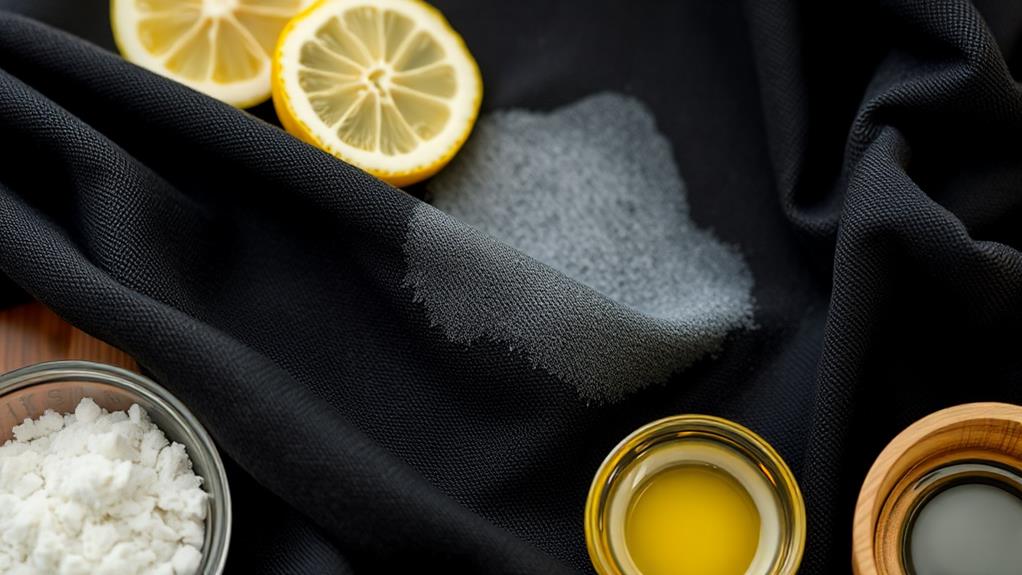
Many effective household remedies can help you tackle bleach stains on dark clothes while also pondering the environmental impact of your cleaning methods.
Incorporating eco-friendly solutions aligns with the principles of sustainable fashion, ensuring that your approach is both effective and responsible. Using common household items like vinegar, baking soda, and hydrogen peroxide can yield great results if you act quickly.
Here are some DIY tips to ponder:
- Baking soda paste: Mix equal parts baking soda and water to create a paste. Spread it over the bleach stain and let it dry before gently brushing it off to minimize discoloration.
- Rubbing alcohol: Dab a cotton ball with rubbing alcohol around small bleach stains. This technique may allow excess dye to return to the affected area, helping to blend the colors.
- Lemon juice and sunlight: Apply lemon juice to the bleach stain and place the garment in sunlight. This natural bleaching agent can help lighten the stain, but be careful to avoid further damage to your dark clothes.
For minor bleach spots, fabric markers can be a lifesaver. They allow you to match the color of your dark clothing and effectively cover up those pesky bleach stains.
When to Seek Help
While household remedies can work wonders for minor bleach stains, there are times when professional help becomes necessary. If your attempts to remove bleach stains have failed after several DIY methods, it's wise to consult a professional cleaner. They possess specialized stain removal techniques and commercial-grade products that can effectively tackle stubborn stains without further damaging your fabric.
Additionally, accurate categorization of your household expenses, such as cleaning services, can aid in budgeting and forecasting for future needs, enhancing your financial management streamlined bookkeeping processes.
Delicate fabrics, like silk or wool, require extra care. Attempting to remove bleach stains on these materials can lead to irreversible damage, making professional intervention a safer option for your valuable items. If you notice the fabric worsening after your treatment attempts, don't hesitate to seek help.
When searching for assistance, consider checking online reviews or asking for cleaning service recommendations from friends or family. Look for professionals who specialize in stain removal for the specific type of fabric you're dealing with.
Best Practices for Laundry
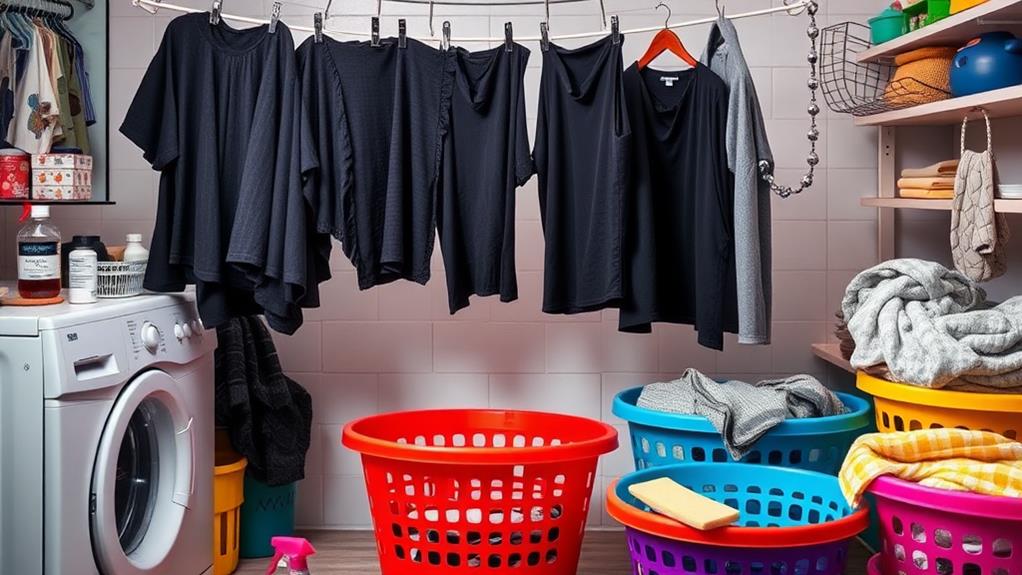
To keep your dark clothes looking their best, it's vital to follow some best practices for laundry. By doing so, you can avoid bleach stains and keep your garments in top condition. Here are some key tips to remember:
– Always separate whites from colors before washing to prevent any cross-contamination and potential bleach stains on your dark garments.
Additionally, utilizing tools like expense tracking tools can help manage your laundry costs effectively.
- Check care labels for specific cleaning instructions to guarantee you're using the right cleaning products and avoiding inappropriate detergents or bleach.
- Use color-safe detergents and bleach alternatives to minimize the risk of bleach stains while still effectively cleaning your clothes.
Regularly maintaining your washing machine is important, too. This helps eliminate any residual bleach or detergent buildup, which could lead to unintentional stains from clothes.
It's also significant to educate all household members about proper bleach usage and to wear protective gear during laundry processes.
Conclusion
Removing bleach stains from dark clothes can feel like a battle between light and shadow. While the vibrant hues of your favorite shirt may seem lost, hope isn't gone. With the right techniques and remedies, you can restore life to your fabric. Embrace the journey of repair, transforming what once appeared ruined into a symbol of resilience. Remember, your garments hold stories; don't let a bleach stain overshadow their brilliance. Keep your wardrobe shining, even amid the mishaps.

